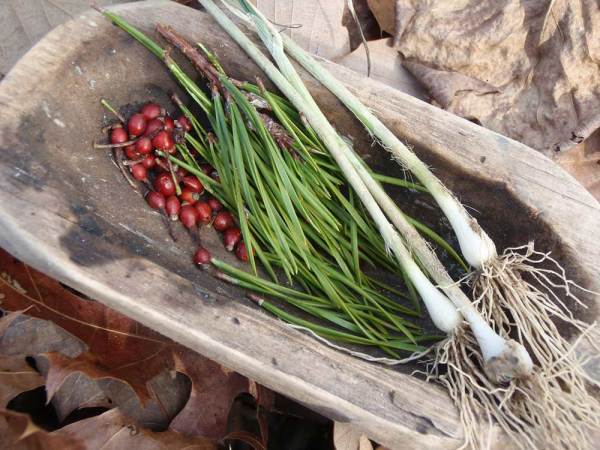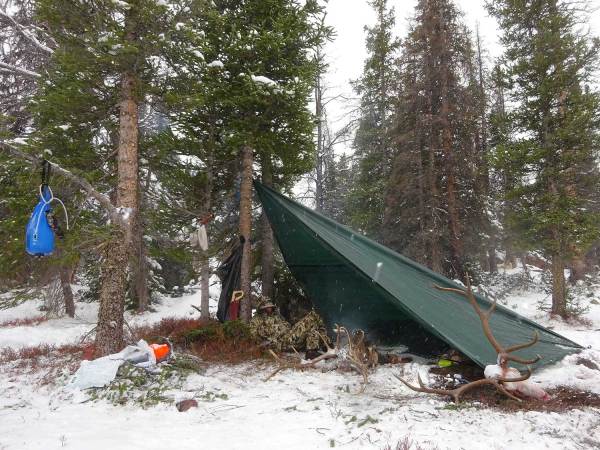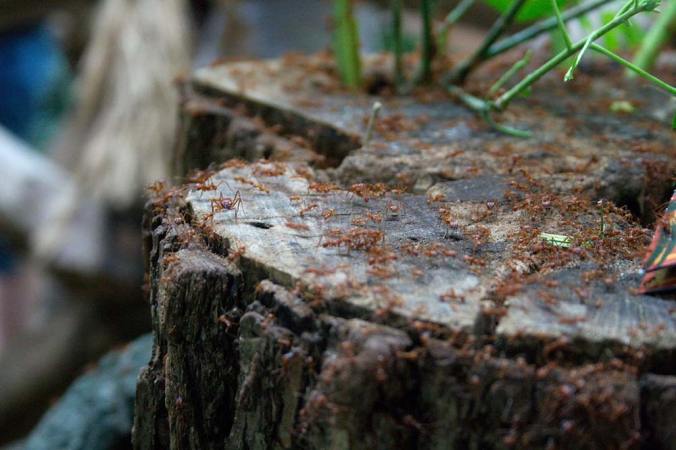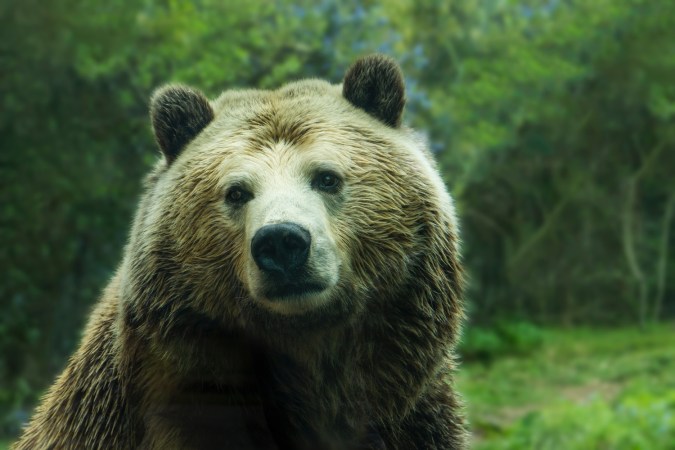

This story originally featured on Outdoor Life
If you want to be a true outdoorsman or woman, and a true survivor, you’ve got to become a plant person.
I know, I know—it’s not as cool to walk around with your nose in a book as it is to sling lead or light stuff on fire. But at the end of the day, plants give us so much that we’d be crazy not to pay attention to them. Some of the most helpful (and long-lived) plants are trees, and it’s our job as survivalists to learn the merits and problems with each species we encounter.
Sure, trees all look very similar at first, but once you start to see the subtle differences, you’ll start to see trees as easily a bloodhound can pick out a fresh scent. Trees have given our ancestors the building blocks for self-reliance, and those same trees are here to help us today. From fiber and medicine, to food and drinking water, many tree species have something to offer us through all four seasons. Get to know these 15 common genera through this gallery of useful survival trees (and a few bonus woody plants).
1. Mulberry
The sweet ripe berries are a delicious treat (when they’re not splattering all over your truck in early summer), but did you know that the mulberry tree provides more than just fruit?

Identifying features: Mulberry trees are medium-sized trees, reaching heights of 40-50 feet tall. When the blackberry-reminiscent fruits are absent, look for simple leaves with a sawtoothed edge and irregular patterns of lobes and sinuses (some leaves have rounded “notches”—some don’t). These deciduous trees are alternate branching, and most leaves have a fuzzy texture.
Range: The native species (Morus rubra) is found from Massachusetts to Florida and west to Kansas and Nebraska. The non-native species (like black mulberry and white mulberry) are found throughout the lower 48 states.
Camp uses: The inner bark can be stripped from branches and shoots to make a very strong cordage material. These fibers can also make fair tinder, and the wood can be used as a medium-quality firewood.
Edible and medicinal uses: The ripe berries can be eaten raw, cooked, or dried. An 8-ounce cup of raw mulberries contains 60 calories, some potassium, and nearly a full day’s worth of vitamin C.
Problems and hazards: The unripe berries are just toxic enough to cause nausea, vomiting, and the occasional hallucination. Wait for them to become soft and sweet before eating.
2. Beech
Aside from its important job of aging our Budweiser beer, beech wood is a survival staple for those who are lucky enough to live within the tree’s natural range.

Identifying features: Beech trees (Fagus grandifolia) are deciduous hardwood trees that are typically 60 to 80 feet tall. Their alternate simple leaves have very small teeth on the leaf edges. One standout feature for identifying this tree is the texture of the bark. Beech has a light gray bark that is very smooth, regardless of the tree’s age or diameter.
Range: This native tree is found in Utah, Texas, and the eastern half of North America.
Camp uses: Beech tree wood is hard and tough, and it breaks into long splinters. It’s a great candidate for firewood and kindling. Dead leaves frequently hang on the tree throughout winter, providing you with dry, papery material for tinder.
Edible and medicinal uses: The nut of a beech tree can be a valuable and delicious wild food source, but you’ll have to be quick to beat the squirrels to them. Native American tribes, such as the Potawatomi, pounded the roasted seeds into flour, and many other cultures have used the oily, sweet nuts for food. Look for the smooth-barked trees in the eastern woodlands, and look for the small, 3-sided seed falling out of a prickly husk around early October. The nuts have 10 grams of carbohydrates, 2 grams of protein, and 164 calories per ounce.
3. Maple
It’s not just the tree that inspired your artificially flavored breakfast-table corn syrup. Oh no—maple is far more than a one-hit-wonder.

Identifying features: From small shrubby species to towering 150-foot-tall monsters, maples (the genus Acer) are most commonly identified by their opposite leaves and branches. The typical leaves have a mixture of large and small teeth, with a palmate vein structure. Not sure what that looks like? Check out the Canadian flag—it’s on there.
Range: Maples are found throughout the Northern Hemisphere, though the biggest diversity of species actually occurs in Asia.
Camp uses: The wood from maple is good firewood, which can be chopped into chunks for smoking foods. Dead dry wood from most maple species can be used for serviceable friction fire kit components and even make a passable bow for archery.
Edible and medicinal uses: Many species produce edible seeds inside the little “helicopters” that spin down from the tree. Remove the bean-shaped seeds from their papery coverings and boil them as you would cook real beans. Most species can be tapped in late winter to harvest their sap, which is then boiled down into sweet syrup.
4. Cedar
Cedar species and their appearances vary, but these useful trees can all be used in much the same way. These fire-friendly trees are a great friend to those in need.

Identifying features: You won’t find any pinecones here (these evergreen trees and shrubs have small bluish berries), and you won’t find any pine needles either. The evergreen foliage of cedar trees is scaly and branching. Maximum sizes vary by species, but most cedars have either a “Christmas tree” shape, or grow as low-spreading shrubs. Most of the trees which we would call cedar are actually junipers, and these have two different kinds of foliage. Young leaves are short sharp needles, and adult leaves form flat sprays of overlapping and scale-like needles.
Range: Several different genera are called “cedars”, and these have a global reach. The common “red cedar” (Juniperus virginiana) is found from Texas to South Dakota, and east to the Atlantic coast.
Camp uses: The roots and bark of many “cedar” species can be used for basketry material and cordage. Fibrous bark can be pounded into tinder, and even woven clothing and blankets. Most cedar species contain enough flammable resin in their wood to be a great kindling material, and they typically make an excellent friction fire material.
Edible and medicinal uses: The ripe berries of some species can be used as a spice.
Problems and hazards: The berries of many cedars are slightly toxic, not that you’d want to eat them anyway: They are essentially a blue skin over a large hard seed.
5. Ash
Enjoy this genus while it lasts, because ash is heading the way of the dodo bird thanks to an invasive burrowing beetle that kills mature trees.

Identifying features: There are more than fifty species of ash worldwide, and most are tall and straight growing, creating excellent timber and lumber for specialty work. Ash trees are opposite branching (like maple), but they have compound leaves that look more like hickory leaves. The seeds are held in small papery strips, resembling small straight maple seed pods.
Range: Ash trees (the genus Fraxinus) are found throughout Europe, Asia, and North America.
Camp uses: Ash is a hardwood that is dense and tough, yet elastic. This makes great firewood, furniture, archery bows, baseball bats, and many other objects.
Problems and hazards: The emerald ash borer beetle is wiping out this majestic tree, so familiarize yourself with it while you still can.
6. Sycamore
This multi-colored tree provides firewood, drinkable sap, sweet syrup, and even wooden items as diverse as bowls and bows.

Identifying features: Large maple-like leaves often confuse observers, but look again and you’ll see that the leaves and branches alternate (while maple is opposite branching). The odd bark is another key factor for identification: It can be distinguished from other trees due to its mottled appearance. As flakes peel off in irregular patterns, they leave behind a mottled smooth bark with patches of green, white, gray, and tan. Sycamores can reach a massive size, with full-grown trees frequently exceeding 100 feet tall and 6 feet in diameter at the base. Some 13-foot diameters have been recorded in recent times, and historic specimens were reportedly larger still. In 1744, a Virginia Colony settler named Joseph Hampton spent a year living inside a giant hollow sycamore—with his two sons.
Range: The American sycamore (Platanus occidentalis) is found in the eastern U.S., while other sycamore species are native to the western states.
Camp uses: Even though the wood is difficult to split, sycamore wood still makes good firewood. It’s also favored for woodworking, particularly in projects where cracking is a problem (like wooden bowls). The wood also makes a fair bow for archery, and successful friction fire drills, boards, bows and hand hold blocks.
Edible and medicinal uses: In the warmer days of mid-winter, you can tap sycamore trees just as you would tap maple trees: to collect sap for drinking water and to boil down into sweet syrup.
7. Black locust
Prickly twigs and clusters of fragrant flowers mark this super-tough and rot-resistant tree. Use it for a phenomenal bow making wood and some tasty treats.

Identifying features: Black locust (Robinia pseudoacacia) is a thorny “pioneer species”—frequently the first tree to grow back after a farm field lies fallow in a woodland region. Look for alternate compound leaves and thorns in sets of two. Cream-colored flowers hang from the branches in large grape-like clusters in late spring.
Range: The original range of the black locust is the mid-Atlantic and a few central states in the U.S., however the tree is now naturalized throughout the world and considered an invasive species in western states (as well as Africa and Australia).
Camp uses: The wood is very dense, hard, and extremely resistant to decay. Black locust posts usually last for decades. The wood also makes exceptional bows. Dead or dying locust trees are the host for a shelf fungus called the cracked cap polypore. Powder from the caramel-colored core of this woody mushroom makes a great tinder additive.
Edible and medicinal uses: The sweet-scented flowers of black locust can be battered and deep fried for amazing fritters or blended with sugar and yeast to make fine homemade wine.
Problems and hazards: Black locust makes great firewood, but don’t cook directly over a fire from it or use the fibrous inner bark as tinder—it’s mildly toxic.
8. Pawpaw
You wouldn’t expect to find this exotic looking fruit in the temperate forests of North America, but there it is. The pawpaw is a strange native fruit with a unique flavor.

Identifying features: The pawpaw (Asimina triloba) is a deciduous tree in the custard apple family (Annonaceae). Pawpaw has large alternate simple leaves, and fruits that resemble chubby bananas that are 2 to 6 inches long and 1 to 3 inches wide, and full of large brown seeds.
Range: It can be found in flood plains and forests through its native range in the southern, eastern, and mid-western U.S., and southern Ontario.
Camp uses: Pawpaw wood is very soft and lightweight. This makes the wood burn too quickly for proper firewood, but it also makes the wood perfect for friction fire equipment. The fibrous inner bark also makes great tinder and workable cordage.
Edible and medicinal uses: These tropical-looking fruits carry 80 calories per cup, with loads of vitamin C and potassium. The sweet, strange flavor is a little like a banana with a hint of mango. Look in August on trees near rivers. Pick them when they are fragrant and almost mushy, but before they rot and turn dark. They are best when eaten raw, though they can be cooked in desserts or turned into an interesting dried fruit.
9. Cottonwood
A gulch full of cottonwood can give you the means to make fire in many different ways.

Identifying features: Often tricky to distinguish from one another, cottonwoods (the genus Populus) are deciduous woody plants in the willow family (Salicaceae). Look for triangular or circular leaves with a long leaf stalk. Alternate branches and a cottony seed down are also found throughout the genus. This group shows a wide genetic diversity, with some species topping out at 50 feet tall while others can grow to 150 feet.
Range: Native species can be found throughout North America and Asia.
Camp uses: The soft wood is excellent for friction fire equipment and the cotton-like seed down is an excellent tinder additive. Though it is a fast-burning firewood, it is easily carved into bowls and spoons, and the boiled bark has long been a source for tannic acid to tan leather.
Edible and medicinal uses: The bark of many poplar species, particularly the white poplar (Populus alba) contain salicylates just like their cousins, the willows. It is from this original source that aspirin is derived.
Problems and hazards: The levels of salicin vary from species to species (even tree to tree), do your research before you start using local cottonwoods for analgesic tea.
10. Willow
Willows may be large trees or small shrubby plants, but they are a great group to get acquainted with. These trees can provide fire materials and pain relieving medicine.

Identifying features: The genus Salix contains over 400 species of alternate branched deciduous trees and shrubs, most with slender simple leaves and toothed edges.
Range: Willows are commonly found in the moist soils of the cold and temperate regions of the Northern Hemisphere.
Camp uses: Most willow twigs and shoots are flexible and make great baskets. The wood makes great friction fire drills and boards.
Edible and medicinal uses: To prepare willow as a medicine, pick one that you can easily identify. Weeping willow is a common tree throughout North America. Though not native, it prospers in any moist area and can be identified by its perennially depressed and droopy twigs and branches. The leaves and bark have been used as medicine for centuries. Boil a handful of green leaves in one cup of water for 10 minutes to create an astringent. Soak a clean cloth in this brew and apply it directly to boils, abscesses, carbuncles, and ulcers when no other medical treatment is available. Scraping the bark off several twigs and soaking that in one cup of hot water for 10 minutes will give you a bitter tasting anti-diarrhea drink. Take a few sips every 2 hours, and continue until the symptoms subside. Bark from several other species in the willow family, including the black willow, has been used since at least 400 B.C. to treat inflammation and pain. Black willow bark contains salicin, a predecessor to aspirin. It was once common for people to chew directly on the shaved bark for pain and fever relief.
11. Hickory
Like pecans? Then you like hickory. Pecan is a southern species of hickory with a flavor that resembles most other hickory nuts.

Identifying features: These trees are deciduous hardwood trees found in North America and Asia. The leaves are alternate compound and the nuts have a “double” nutshell. There’s a husk that peels off, revealing a nutshell underneath. Just make sure you don’t mistake a buckeye for walnuts: They have a double-layered nutshell like hickory, but buckeye nuts are poisonous to humans. Hickory nuts have a multi-chambered inner nutshell (like a walnut), while buckeyes have a solid nutmeat (like an almond).
Range: Hickories are found in Asia, the United States, Mexico, and Canada.
Camp uses: Hickory wood makes a great bow. It’s also a long-burning firewood that’s good for smoking meats and cheeses too. And it you need a hardwood for tool and knife handles, hickory has you covered.
Edible and medicinal uses: Hickory nuts are the most calorie-dense wild plant food in this roundup. One ounce of shelled out hickory nut meats packs a whopping 193 calories, with most of that coming from fat. Most hickory nuts taste like their most famous relative (the pecan). These sweet and fatty nut meats can be used as a raw food, picked right out of the shell.
Problems and hazards: There are a few species of hickory that have very bitter nuts. They aren’t harmful to eat, but they are so nasty that you won’t be able to consume them.
12. Birch
Birches are lovely trees, and they offer us some unique bark for utilitarian purposes, as well as tea and medicine. Oh yeah—and some of the bark even burns when it’s soaking wet.

Identifying features: Smooth bark that peels off in papery strips is a hallmark for this group of trees. Bark color may vary from a dark charcoal grey to bright white, and the alternate simple leaves have small teeth on the edges. You can spot a grove of white paper birch trees from a mile away.
Range: Paper birch is found through the northern half of North America, and the sweet birch is found through the northeastern U.S. Many other species are found through the northern half of the Northern Hemisphere.
Camp uses: The papery outer bark (particularly of the paper birch) makes a great fire starter, even when wet. The wood is also a workable firewood choice. Paper birch bark has been used for centuries to make various containers and even canoes.
Edible and medicinal uses: The sweet birch (Betula lenta) twigs are broken up and steeped as a delicious tea. Birch bark, particularly the sweet birch bark, can also be an effective analgesic if it has enough salicylates. This bark is best scraped from the tree’s twigs, and can be safely taken long-term at recommended doses. If any reactions develop, stop taking it. A suggested dosage for salicin is 6 to 120 mg per day. Sweet birch bark tea can be prepared by adding 1/4-1/2 teaspoon of dried twig bark scrapings to on cup of hot water and then steeping for ten minutes. This tea can be taken up to five times per day. The sap can also be tapped in spring for drinking water and syrup.
Problems and hazards: Higher-than-recommended doses of birch tea can cause upset stomach, nausea, or tinnitus (ringing in the ears).
13. Black Walnut
These remarkable trees provide food, medicine, dye, and useful wood, and when the nuts are present, they become very easy to identify.

Identifying features: Walnuts are tall growing deciduous hardwood trees with round or oblong nuts. Black walnuts (Juglans nigra) look like green tennis balls when they are freshly fallen, but the rough, round husks turn from green to a very dark brown as they lay on the ground in autumn. The leaves of walnut are alternate compound leaves.
Range: Black walnut trees are found in the eastern half of the lower 48 states.
Camp uses: The hard, mineral rich wood has been used for knife handles and gunstocks for centuries. The green and black nut husks can be boiled into dye for cloth. If the husks were still green, you’ll end up with a bucket of yellowish-brown dye. If the husks have already turned black, your dye will be dark brown.
Edible and medicinal uses: The tasty nutmeat contains 173 calories an ounce, with a fair bit of protein, magnesium, phosphorus, copper, and manganese. One tablespoon of the dried green husk material in one cup of hot water will make a horrible-tasting yet parasite-expelling tea. Sip on one cup over the course of a day and repeat this for seven days. The fresh green husks can be dried and soaked in alcohol for 6 weeks to create a substitute for iodine tincture as an antiseptic on small cuts and wounds.
Problems and hazards: Black walnut wood doesn’t burn well, or make useable friction fire drills or fire boards.
14. Pine
These versatile trees provide us with food, fuel, glue, and other useful things. Make sure you have the right evergreen, and then go crazy with the plethora of piney products.

Identifying features: Pines are easily identified: their needles grow in clusters of 2 to 5 needles in most parts of the world, and they bear tell-tale pinecones.
Range: Pine trees can be found throughout the world, and a variety of species are native throughout the Northern Hemisphere.
Camp uses: Pine heartwood can become “fatwood” when the stumps and roots fill with pitch. This turpentine-scented wood is highly prized because it lights readily with an open flame and burns very well (even in wet weather). Free flowing pinesap can be simmered in a container and mixed with powdered charcoal to create waterproof glue.
Edible and medicinal uses: The dried inner tree bark of pine can be eaten after “skinning” trunks and branches. After grinding into powder, the bark can be added to bread dough or other dishes, and packs more than 500 calories per pound. Pine nuts can be eaten, too. These are fatty and soft, and are picked from larger pine cones. These can be enjoyed raw or cooked as food. One hundred grams of pine nuts have approximately 640 calories and 10 percent of your daily need for potassium. But that’s not all you can consume: A spoonful of chopped pine needles can be steeped in a mug of hot water for 10-15 minutes to make pine needle tea, which is a Vitamin C powerhouse (one serving contains as much as five times your daily requirement).
Problems and hazards: Pine needle tea may be harmful to unborn babies, so moms-to-be should skip this drink – especially in the first trimester.
15. Oak
If you’re stuck near oak trees that are producing acorns, you actually have almost everything you need to survive. Oaks give us fire, food, medicine, shelter, and so much more.

Identifying features: There are approximately 600 species of “oak” throughout the world. This list includes deciduous and evergreen tree species found in cool climates down to warmer tropical latitudes. Oaks have alternate simple leaves in a wide variety of sizes and shapes. North America contains the largest number of oak species, with a surprising diversity of 160 species in Mexico. The fruit of the oak tree is a nut called an acorn, borne in a cup-like “cupule.”
Range: Oak species are found throughout the Northern Hemisphere.
Camp uses: The inner bark can be boiled to make a dark tea-colored liquid that is medicinal, and it can help with traditional hide tanning. The wood makes great firewood and strong shelter poles.
Edible and medicinal uses: One ounce of acorn nutmeat contains a little over 100 calories, which many of our ancestors ate as a staple food prior to agriculture. The bitter acid in them is easily removed by cracking them into pieces and soaking the acorn meat chunks in repeating baths of warm water, one hour at a time, until the bitter taste has been completely leached away. Just make sure to save the first water bath from the acorn soaking. It can be used topically to reduce inflammation, heal rashes, and ease other skin ailments.
Problems and hazards: Eating acorns that still contain too much tannic acid can cause nausea and digestive distress. Don’t even try to use oak for friction fire drills and boards—it’s too dense and the ignition temperature is too high.
Bonus woody plants
These plants are common and useful for not only survival, but some for medical purposes as well. Others are plants you should be able to identify so you’re able to stay far away while walking in the woods.
Wild grape vines
These familiar vines (Vitis spp.) have a lot to offer the survivalist who is observant enough to find them.
Identifying features: Wild grapes are deciduous woody vines that are found throughout the world, thanks to their native populations and cultivation. Grapes have alternate simple leaves that are heavily toothed. More than 20 species of wild grape are found east of the Mississippi, ripening at different times from August through October. Make sure that most of the fruits in each cluster have 2 to 4 pear-shaped or teardrop shaped seeds inside each fruit (though the odd grape in the bunch may only form one seed, but it will still be the right shape).
Range: Wild grapes are found primarily in the eastern half of the lower 48 states, though they are present throughout the continent (when they escape cultivation to grow wild).
Camp uses: Baskets are can be made from more flexible vines. The larger vines can also produce safe drinking water in the springtime. Cut into vines to start testing, right around the time that the leaves are forming in spring. When the weather is right, drinkable sap will drip or dribble from the cut area.
Edible and medicinal uses: Depending on the species and sugar content, wild grapes are roughly 100 calories per cup. Most wild grapes carry descent amounts of vitamin C, vitamin K, copper and potassium (one-tenth to one quarter of your daily requirement).
Problems and hazards: Make sure you don’t mistake grape for poison ivy vines, and don’t confuse grapes with Moonseed fruit. The Canada moonseed looks like a grape, but it is poisonous. Grapes should have two to four teardrop shaped seeds, while the dangerous moonseed has only one seed which is curved and flat. The grape vines also have tendrils (curly Q’s), while the moonseed has no curly tendrils.
Blueberry bush
The fruit provides an easy way to identify the shrub, though it can be differentiated without the tell-tale berries.
Identifying features: Blueberries (Vaccinium spp. and Gaylussacia spp.) are perennial woody bushes that may be very short (like “low bush blueberry” species, under 1 foot tall) or they may be very tall (like “high bush blueberries” species, over 12 feet tall). Their simple alternate leaves are ovate to lanceolate, and ½ to 3 inches long. It’s the assortment of leaf sizes that catch my eye when the berries are not in season. It looks as if the bush has baby leaves, midsized leaves and large leaves all at the same time. The small flowers are bell-shaped, and are colored white, pale pink or red. The berry has a little 5 pointed “crown” at the end. The berries go from pale greenish at first, to a reddish color, then finally to dark purple when ripened.
Range: Wild blueberries can be found throughout the lower 48 states.
Camp uses: The taller species with more spindly shoots may be harvested for arrow shafts.
Edible and medicinal uses: The flavorful berries can be eaten raw or cooked. They can also be dried for storage, or used in a dry state for diarrhea relief. Try eating 6-10 dried blueberries every hour, until the symptoms improve. Blueberry leaves may be used fresh or dried to brew a mild tasting herb tea which is loaded with anthocyanin (a powerful antioxidant) and gallic acid (which is an anti-inflammatory compound).
Problems and hazards: Make sure it really is a blueberry before eating any fruit, since some bluish colored berries you’ll encounter in the wild are very dangerous.
Poison ivy
You’ll definitely want to learn this plant (so you can avoid it). You may have heard the old adage, “Leaves of three, leave it be.” That can sometimes be enough to keep you out of trouble, but it’s a far better strategy to learn to identify this vexing plant in all stages and seasons.
Identifying features: Poison ivy (Toxicodendron radicans) can wear many masks. During the growing season, the three leaflets of this compound leafed plant are fairly distinctive (though plenty of other plants have leaves in sets of three). Young spring leaves may have a shiny surface, tinged with copper or reddish colors. Immature plants can look like herbaceous plants or baby trees, older ones can even present like shrubs (when they have nothing to climb). The plants can also appear alternate leafed fuzzy vines climbing up rocks, trees and structures.
Range: “Eastern” poison ivy can be found in the eastern half of the U.S. and Canada, with at least eight subspecies present. There’s also a “western” species, so you folks that are west of the Mississippi don’t feel left out.
Plant uses: Baskets for your enemies (just wear thick disposable gloves while weaving). But seriously, this plant does provide food for many animals.
Problems and hazards: Touching any part of this plant (or things that touched the plant) can transfer the oil of poison ivy. This soaks into your skin and causes a rash in most people. Worst of all, burning the plant releases the oils in to the air – which can then enter your lungs.













